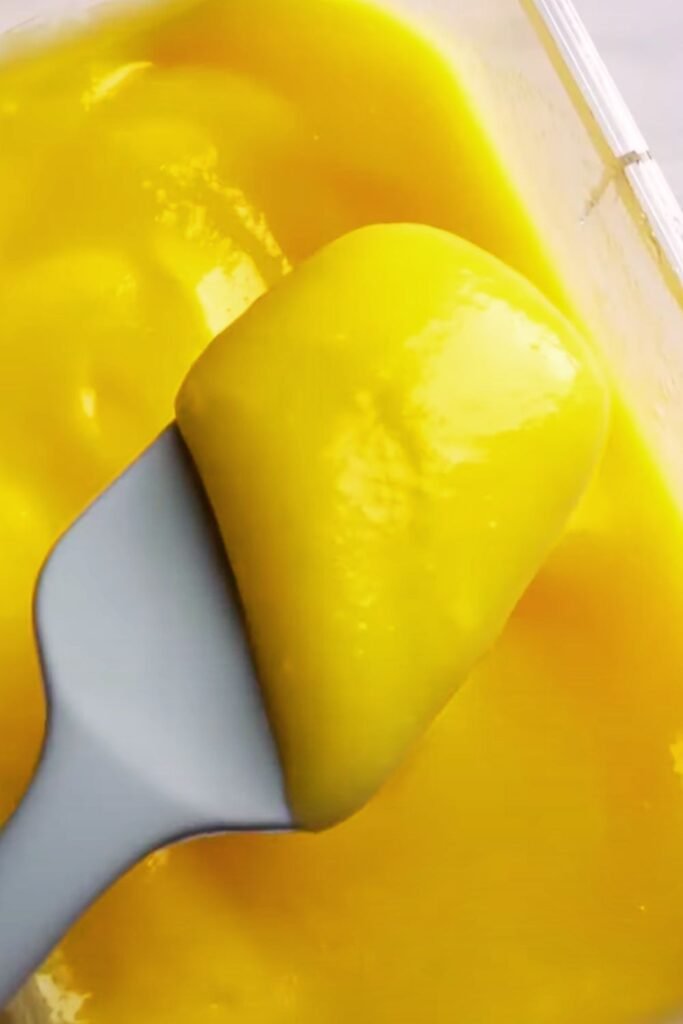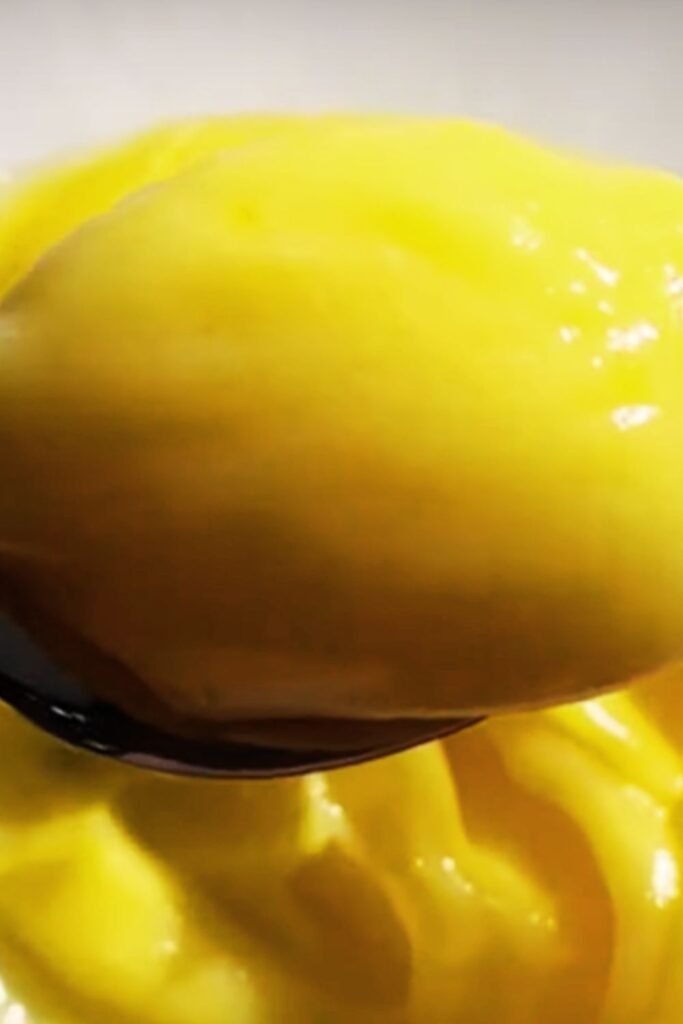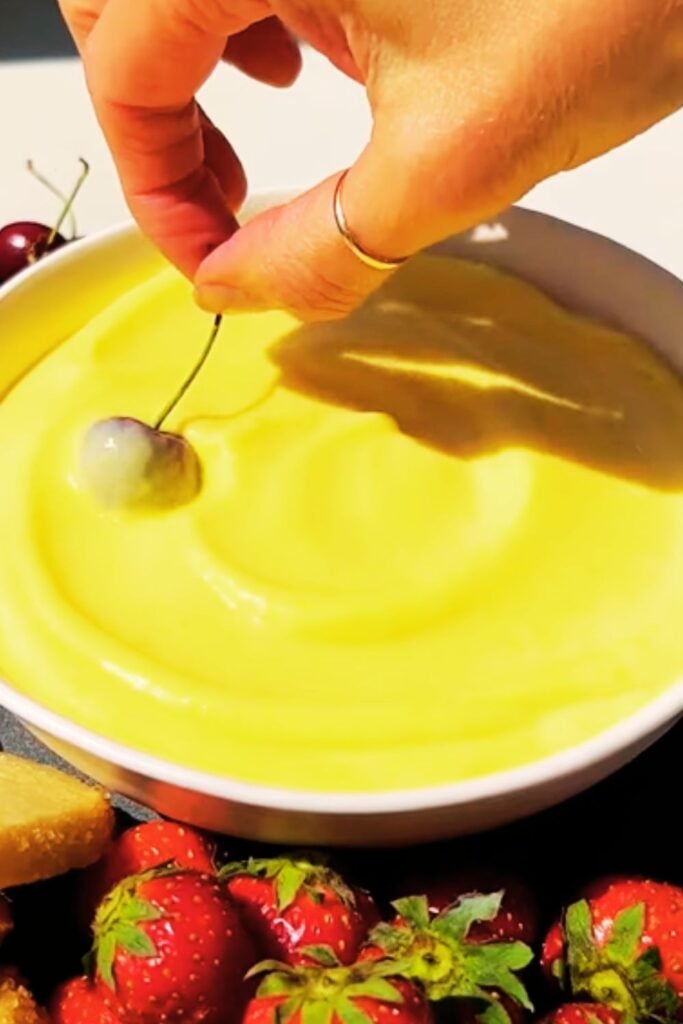When I first tasted homemade lemon curd at my grandmother’s house, I knew I had discovered something magical. That bright, tangy sweetness with its luxurious, velvety texture was unlike anything I’d ever experienced from a store-bought jar. Today, I’m sharing my perfected lemon curd recipe that has become my go-to for everything from teatime treats to elegant dessert accompaniments.
Lemon curd is one of those deceptively simple recipes that can elevate any dessert from ordinary to extraordinary. With just a handful of ingredients and some patience, you can create this golden treasure that captures the essence of sunshine in every spoonful.
What Is Lemon Curd?
Lemon curd is a rich, creamy spread that combines the tartness of fresh lemons with the richness of eggs and butter. Originally developed in England during the 19th century, this preserve-like delicacy has become a beloved staple in kitchens worldwide. The texture should be smooth and thick enough to coat the back of a spoon, yet spreadable enough to use as a filling or topping.
The beauty of lemon curd lies in its versatility. I use it as a filling for tarts, a topping for scones, a layer in cakes, or simply spread on toast for a luxurious breakfast treat. The key to perfect lemon curd is achieving the right balance between acidity and sweetness while maintaining that silky-smooth texture that makes it so irresistible.
Essential Ingredients for Perfect Lemon Curd
The magic of lemon curd comes from using high-quality, fresh ingredients. Each component plays a crucial role in creating the perfect texture and flavor profile.
Fresh Lemons
I cannot stress enough how important it is to use fresh lemons rather than bottled lemon juice. Fresh lemons provide not only the juice but also the aromatic oils from the zest that give lemon curd its complex flavor. When selecting lemons, I look for fruits that feel heavy for their size and have bright, unblemished skin. Meyer lemons work beautifully if you can find them, offering a slightly sweeter, more floral flavor.
Eggs
The eggs are what give lemon curd its luxurious, custard-like texture. I always use large, fresh eggs at room temperature. The yolks provide richness and act as a natural thickener, while some recipes benefit from using whole eggs for additional structure. Room temperature eggs incorporate more easily and reduce the risk of curdling.
Butter
High-quality unsalted butter is essential for creating that silky mouthfeel. I prefer European-style butter for its higher fat content, which results in a richer, more luxurious curd. The butter should be at room temperature for easy incorporation, and I always add it gradually to prevent the mixture from breaking.
Sugar
Granulated sugar dissolves easily and provides the necessary sweetness to balance the tart lemons. Some bakers prefer superfine sugar, which dissolves even more readily, but regular granulated sugar works perfectly fine with proper technique.
My Foolproof Lemon Curd Recipe
This recipe yields approximately 1½ cups of lemon curd, enough to fill a 9-inch tart or provide plenty for multiple uses.
Ingredients
| Ingredient | Amount | Notes |
|---|---|---|
| Fresh lemons | 4-5 large | Should yield ⅔ cup juice and 2 tablespoons zest |
| Large eggs | 3 whole + 1 yolk | Room temperature preferred |
| Granulated sugar | ¾ cup | Can adjust to taste |
| Unsalted butter | 6 tablespoons | Cut into small pieces |
| Salt | Pinch | Enhances overall flavor |
Equipment Needed
| Item | Purpose | Alternative |
|---|---|---|
| Heavy-bottomed saucepan | Even heat distribution | Double boiler |
| Fine-mesh strainer | Smooth texture | Clean kitchen towel |
| Whisk | Proper mixing | Fork (less effective) |
| Microplane grater | Zest extraction | Fine grater |
| Citrus juicer | Maximum juice extraction | Hand squeezing |

Step-by-Step Instructions
Preparation Phase
I always start by preparing all my ingredients before I begin cooking. This French technique called “mise en place” is crucial for lemon curd success because the cooking process requires constant attention.
First, I zest my lemons using a microplane grater, being careful to avoid the bitter white pith underneath. Then I roll the lemons on the counter while pressing down to break the internal membranes, which helps release more juice. After cutting them in half, I juice them through a fine strainer to remove any seeds or pulp.
The Cooking Process
In my heavy-bottomed saucepan, I whisk together the eggs, egg yolk, and sugar until the mixture becomes pale and slightly thickened. This usually takes about 2-3 minutes of vigorous whisking. The mixture should fall in ribbons when the whisk is lifted.
Next, I add the fresh lemon juice and zest, whisking constantly to combine. At this point, the mixture will be quite thin, but don’t worry – that’s exactly what we want.
The Critical Cooking Stage
Here’s where patience becomes crucial. I place the saucepan over medium-low heat and begin stirring constantly with my whisk. The key is maintaining gentle, consistent heat while never stopping the stirring motion. I use a figure-eight pattern to ensure even heating throughout the mixture.
The transformation happens gradually. After about 5-7 minutes, I notice the mixture beginning to thicken. It’s subtle at first, but then it becomes more apparent. I’m looking for the consistency to coat the back of a spoon and hold a line when I draw my finger across it.
Temperature is critical here. If I have a thermometer, I aim for 170°F (77°C). Higher temperatures risk curdling the eggs, while lower temperatures won’t properly thicken the curd.
Finishing Touches
Once the curd reaches the proper consistency, I immediately remove it from heat. Working quickly, I add the butter pieces one at a time, whisking until each piece is completely incorporated before adding the next. This gradual incorporation ensures a smooth, glossy finish.
The final step is straining the curd through a fine-mesh strainer to remove any lumps or bits of cooked egg that might have formed despite my careful attention. I press the curd through with the back of a spoon, ensuring I capture every bit of that golden goodness.

Troubleshooting Common Issues
Curdled Lemon Curd
If my lemon curd starts to curdle, don’t panic. I immediately remove it from heat and strain it through a fine-mesh strainer while it’s still warm. Then I transfer it to a blender and process on high speed for 30-60 seconds. This usually rescues even badly curdled curd by re-emulsifying the mixture.
Too Thin Consistency
When my curd doesn’t thicken properly, it’s usually because the heat was too low or I didn’t cook it long enough. I return it to low heat and continue cooking while stirring constantly until it reaches the proper consistency. Adding an extra egg yolk, whisked in a small bowl first, can also help thicken a too-thin curd.
Lumpy Texture
Lumps typically result from uneven heating or insufficient straining. I always strain my finished curd, but if I notice lumps forming during cooking, I immediately strain the mixture and return it to the pan to continue cooking.
Overly Tart or Sweet
Flavor balance is crucial in lemon curd. If mine turns out too tart, I can whisk in an additional tablespoon of sugar while the curd is still warm. If it’s too sweet, a tablespoon of fresh lemon juice usually corrects the balance.
Storage and Shelf Life
Proper storage is essential for maintaining both quality and safety. I always press plastic wrap directly onto the surface of my cooled lemon curd before refrigerating to prevent a skin from forming. Stored this way, homemade lemon curd keeps in the refrigerator for up to two weeks.
For longer storage, I freeze lemon curd in small portions using ice cube trays or small containers. Frozen lemon curd maintains its quality for up to three months. When I’m ready to use it, I thaw it overnight in the refrigerator and give it a good stir before using.
Nutritional Information
Understanding the nutritional content helps me make informed decisions about serving sizes and dietary considerations.
| Nutrient (per 2 tablespoons) | Amount | % Daily Value |
|---|---|---|
| Calories | 145 | 7% |
| Total Fat | 6g | 9% |
| Saturated Fat | 3.5g | 18% |
| Cholesterol | 95mg | 32% |
| Sodium | 25mg | 1% |
| Total Carbohydrates | 24g | 8% |
| Sugars | 23g | – |
| Protein | 2g | 4% |
| Vitamin C | 8mg | 13% |
Creative Uses and Serving Suggestions
The versatility of lemon curd continues to amaze me. Beyond the traditional scone topping, I’ve discovered countless ways to incorporate this golden delight into my cooking and baking.
Dessert Applications
I love using lemon curd as a filling for layer cakes, creating beautiful contrast against vanilla or chocolate cake layers. It makes an excellent tart filling, either on its own or topped with fresh berries. For elegant individual desserts, I layer it in glasses with whipped cream and crushed cookies for an instant trifle.
Breakfast and Brunch Ideas
Lemon curd transforms ordinary breakfast items into special occasions. I swirl it into yogurt for a luxurious parfait, spread it on croissants or muffins, or use it as a filling for crepes. It’s also wonderful stirred into oatmeal or used as a topping for pancakes and waffles.
Creative Combinations
One of my favorite discoveries is using lemon curd in savory applications. A small dollop pairs beautifully with roasted chicken or pork, and it makes an interesting addition to cheese boards when served alongside mild cheeses and crackers.

Variations on the Classic Recipe
While traditional lemon curd is perfect on its own, I enjoy experimenting with variations that add new dimensions to this classic recipe.
Lime Curd
Substituting fresh limes for lemons creates a more tropical flavor profile. I use the same proportions but often add a teaspoon of lime zest for extra intensity. The beautiful pale green color makes it particularly striking in desserts.
Orange Curd
Orange curd offers a sweeter, more mellow citrus flavor. I typically use a combination of orange juice and a small amount of lemon juice to maintain some tartness. Blood oranges create a stunning deep orange color with a slightly more complex flavor.
Lemon-Lavender Curd
For a sophisticated twist, I infuse the sugar with dried culinary lavender before making the curd. I combine ¾ cup sugar with 1 tablespoon dried lavender buds and let it sit for at least an hour before straining out the lavender and proceeding with the recipe.
Meyer Lemon Curd
When Meyer lemons are in season, I love making this variation. Meyer lemons are sweeter and more floral than regular lemons, so I often reduce the sugar slightly and enjoy the more delicate flavor profile.
Pairing Suggestions
The bright acidity and rich texture of lemon curd make it an excellent companion to many flavors and textures.
Tea Pairings
Earl Grey tea’s bergamot notes complement lemon curd beautifully, while chamomile tea provides a soothing contrast to the curd’s brightness. Green tea also pairs well, with its grassy notes balancing the richness.
Complementary Flavors
Vanilla, almond, and coconut all enhance lemon curd’s natural flavors. Fresh berries provide textural contrast and color, while herbs like thyme or rosemary add unexpected sophistication to desserts featuring lemon curd.
Texture Contrasts
I love pairing the smooth richness of lemon curd with crunchy elements like toasted nuts, graham cracker crumbs, or crispy meringue. These textural contrasts make each bite more interesting and satisfying.
Professional Tips for Perfect Results
After making countless batches of lemon curd, I’ve learned several professional techniques that ensure consistent success.
Temperature Control
I never rush the cooking process. Gentle, consistent heat is far more important than speed. If I’m unsure about my stovetop’s heat levels, I use a double boiler for more controlled cooking.
Ingredient Quality
The quality of ingredients directly impacts the final product. I always taste my lemons before using them, as some can be more or less acidic than others. Adjusting the sugar accordingly ensures consistent flavor balance.
Technique Refinements
I’ve learned to trust the process and not panic if the curd seems too thin initially. Proper thickening happens gradually, and patience always pays off with better results than rushing.
Q&A Section
Q: Why did my lemon curd turn out grainy or lumpy? A: Grainy texture usually results from cooking at too high a temperature, causing the eggs to scramble. Always cook over medium-low heat and stir constantly. If this happens, immediately strain the curd while warm and blend it to restore smoothness.
Q: Can I make lemon curd without eggs? A: Traditional lemon curd requires eggs for its characteristic texture and richness. However, you can make egg-free versions using cornstarch as a thickener, though the texture and flavor will be different from authentic lemon curd.
Q: How do I know when my lemon curd is thick enough? A: The curd should coat the back of a spoon and hold a clear line when you draw your finger across it. It will continue to thicken slightly as it cools, so don’t overcook it.
Q: Can I double this recipe? A: Yes, but use a larger, heavy-bottomed pan and allow extra cooking time. The larger volume takes longer to heat evenly, so patience is even more important with doubled batches.
Q: What’s the best way to prevent skin from forming on stored lemon curd? A: Press plastic wrap directly onto the surface of the cooled curd before refrigerating. This prevents air exposure that causes skin formation.
Q: Can I use bottled lemon juice instead of fresh? A: While possible, fresh lemon juice and zest provide much better flavor and aroma. Bottled juice lacks the bright, complex notes that make homemade lemon curd special.
Q: How can I fix curd that’s too sweet or too tart? A: If too sweet, add fresh lemon juice one tablespoon at a time while the curd is still warm. If too tart, whisk in additional sugar, also while warm, until the balance is right.
Q: Is it safe to eat lemon curd that hasn’t been fully cooked to 170°F? A: For food safety, especially when serving to vulnerable populations, always cook lemon curd to at least 160°F, though 170°F ensures proper thickening and safety.
Q: Can I make lemon curd in advance for special occasions? A: Absolutely! Lemon curd keeps well refrigerated for up to two weeks and can be frozen for three months. This makes it perfect for advance preparation.
Q: Why does my lemon curd sometimes taste metallic? A: This can happen from extended contact with metal utensils or bowls. Use non-reactive equipment like stainless steel or glass, and avoid aluminum or copper cookware.
Creating perfect lemon curd is both an art and a science, requiring attention to detail and patience. With practice, you’ll develop an intuitive sense for the right consistency and timing. The reward is a versatile, luxurious ingredient that transforms ordinary desserts into extraordinary experiences. Whether you’re spreading it on morning toast or incorporating it into elegant desserts, homemade lemon curd brings a touch of sunshine to every bite.